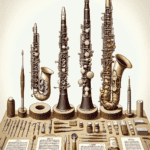Introduction to Clarinet Barrel Designs
The clarinet is a fascinating instrument, particularly when examining the evolution of its barrel designs. The barrel, far from being a simple connector, plays a key role in shaping the instrument's sound and playability. Let's explore the various barrel designs throughout history that have contributed to the clarinet's popularity among musicians.
The Function of the Clarinet Barrel
What exactly does the barrel do? It connects the mouthpiece to the body of the clarinet. This small part has a big job: it helps determine the overall sound of the instrument. The barrel influences everything from tone quality to playing response – it's where the instrument's voice begins to take shape.
Historical Barrel Designs
Over time, barrel designs have changed alongside musical trends and instrument-making techniques. Early clarinets featured straight barrels with a uniform diameter – a classic design you might recognize. As music evolved into the Romantic era, instrument makers began experimenting with different shapes. Curved barrels appeared, offering a more complex sound that resonated beautifully with the music of the time.
| Era | Barrel Design | Sound Characteristics |
|---|---|---|
| Early Classical | Straight, uniform diameter | Clear, direct tone |
| Romantic | Curved | Complex, resonant |
| Modern | Various (straight, curved, tapered) | Diverse, tailored to player preference |
Modern Barrel Materials
Today, the materials used in barrel construction significantly impact the clarinet's sound. Grenadilla wood remains a popular choice, known for its warm and rich tones. It's the go-to material for many clarinetists. However, other materials like metal and synthetic compounds have entered the scene, offering alternatives to traditional wooden barrels. These variations create different sound characteristics, catering to both students and professionals.
The Martin Freres Legacy
The renowned Martin Freres company is known for their exceptional craftsmanship. Their barrels are designed to enhance a clarinetist's performance, striking a balance between sound quality and ease of play. Many professional players prefer Martin Freres barrels, testament to how innovative barrel designs can elevate the playing experience.
The Impact of Barrel Dimensions
Here's an interesting fact: the dimensions of the barrel can affect intonation. A barrel with incorrect proportions can cause tuning issues. It's remarkable how such a small component can have such a significant impact on the instrument's performance!
Variations in Barrel Design
Not all clarinet barrels are the same. You might come across terms like “barrel length” and “barrel taper” in product descriptions. For example, a longer barrel can produce a broader sound with better projection. The taper, on the other hand, influences playing resistance. Understanding these aspects can help clarinetists choose the best instrument for their playing style.
Customizing Clarinet Setups
Musicians often personalize their instruments by combining barrels from different makers. This level of customization allows for a wide range of tonal possibilities. It's similar to a painter selecting different colors for their palette – the options are almost limitless!
Conclusion
The evolution of clarinet barrel designs showcases the perfect blend of art and science in instrument making. Each barrel is carefully crafted to serve a specific purpose, enhancing the player's experience. By understanding this history, musicians can gain a greater appreciation for their instruments and the subtle nuances that make each one unique.







